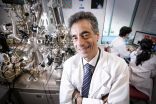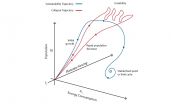(Press-News.org) By combining projections of climate change, emissions reductions and changes in land use across the USA, an international research team estimate that by 2050, cumulative exposure to ozone during the summer will be high enough to damage vegetation.
Although the research findings - published in Atmospheric Chemistry and Physics Discussions - focus on the impact in the USA, they raise wider concerns for global air quality, according to lead researcher Dr Maria Val Martin, from the University of Sheffield's Faculty of Engineering
"Modelling future air quality is very complex, because so many factors need to be taken into account at both a global and local scale," says Dr Val Martin. "The picture isn't uniform across the USA, with some areas seeing much higher surface ozone levels than others. However, our findings show that the emissions reductions we're expecting to achieve won't guarantee air quality on their own, as they will be offset by changes in climate and land use and by an increase in wildfires. This is an issue that will affect all parts of the world, not just the USA."
The research looked at air quality under two scenarios set out by the Intergovernmental Panel on Climate Change: one which envisages greenhouse gas emissions peaking in 2040 and then falling, the other in which emissions continue to rise until 2100. The team combined data on climate change, land use and emissions to create a picture of air quality across the USA in 2050.
The model showed that, if greenhouse gas emissions peak in 2040, then by 2050 surface ozone will remain below levels set to safeguard human health, despite increases in ozone caused by higher temperatures and changes in agriculture and forestation. If emissions continue to rise until 2100, then some areas of the USA will see surface ozone above the safe levels set for human health.
However, when the researchers looked at the cumulative impact of ozone over three months in the summer - a standard growing season - they found that under both scenarios, the surface ozone levels would be high enough to cause damage to plants. This was particularly because during the summer, there were higher emissions from transport and industry of nitrogen oxides, which react with sunlight to create ozone.
"Ozone affects photosynthesis, causing pigmentation on leaves, stunting growth and reducing yield," explains Dr Val Martin. "At a time when the world will need to be feeding a growing population, we need to be sure that our ability to do this isn't compromised by surface ozone. Our model shows that we may need more stringent controls of certain emissions - such as nitrogen oxides or methane - that contribute to ozone levels."
Co-researcher Professor Colette Heald, from Massachusetts Institute of Technology, adds: "Poor air quality is not just an issue in cities. Air pollution in pristine regions such as National Parks degrades visibility and can damage ecosystem health. Protecting natural ecosystems - and our enjoyment of them - will require us to consider and manage the impacts of emissions and climate change on future air quality."
INFORMATION:
The dreaded scratch or puncture test is the most common way of assessing allergic reactions to as many as 40 different substances at once. But because the test involves needles that prick multiple points along the skin's surface, it's a particularly high-stress examination for children -- and their understandably anxious parents.
A new study by Tel Aviv University researchers provides the first quantitative analysis of the role of "medical clowns" in assuaging the anxiety and pain felt by children undergoing allergy tests. The research, published in Allergy, was conducted ...
Far too many "teachable moments" are lost in a doctor's office during which young adults with hypertension could have learned how to reduce their blood pressure. In fact, only one in every two hypertensive young Americans does in fact receive such advice and guidance from a healthcare provider within a year from being diagnosed, says Heather M. Johnson of the University of Wisconsin School of Medicine and Public Health in the US. She led a study which examined how regularly such education is provided and documented by one of the ten largest physician practice groups in ...
A major new Series on health and ageing, published in The Lancet, warns that unless health systems find effective strategies to address the problems faced by an ageing world population, the growing burden of chronic disease will greatly affect the quality of life of older people. As people across the world live longer, soaring levels of chronic illness and diminished wellbeing are poised to become a major global public health challenge.
Worldwide, life expectancy of older people continues to rise. By 2020, for the first time in history, the number of people aged 60 years ...
A car powered by its own body panels could soon be driving on our roads after a breakthrough in nanotechnology research by a QUT team.
Researchers have developed lightweight "supercapacitors" that can be combined with regular batteries to dramatically boost the power of an electric car.
The discovery was made by Postdoctoral Research Fellow Dr Jinzhang Liu, Professor Nunzio Motta and PhD researcher Marco Notarianni, from QUT's Science and Engineering Faculty - Institute for Future Environments, and PhD researcher Francesca Mirri and Professor Matteo Pasquali, from Rice ...
Toronto, ON - For most cancer patients, primary tumours are often not the most deadly. Instead, it is the metastatic tumours - tumours that spread from their original location to other parts of the body - that are the cause of most cancer deaths.
The catalysts behind the formation of these deadly metastatic tumours are believed to be cancer cells that are launched into the bloodstream from the original site of the cancer. Researchers are very interested in leveraging these circulating tumour cells, or CTCs, which have the potential to allow the properties of a tumour ...
The NASA/ESA Hubble Space Telescope has snapped a striking view of a multiple star system called XZ Tauri, its neighbour HL Tauri, and several nearby young stellar objects. XZ Tauri is blowing a hot bubble of gas into the surrounding space, which is filled with bright and beautiful clumps that are emitting strong winds and jets. These objects illuminate the region, creating a truly dramatic scene.
This dark and ominous landscape is located some 450 light-years away in the constellation of Taurus The Bull). It lies in the north-eastern part of a large, dark cloud known ...
Engineers at the University of California, San Diego, are proposing a new surgical intervention for children born with a single ventricle in their heart--instead of the usual two. The new approach would potentially reduce the number of surgeries the patients have to undergo in the first six months of life from two to just one. If successful, it would also create a more stable circuit for blood to flow from the heart to the lungs and the rest of the body within the first days and months of life.
Engineers ran computer simulations of the surgery and found it would reduce ...
Scientists at Helmholtz Zentrum München (HMGU), at Karolinska Institutet (KI), Stockholm and the University College London investigated the function of ciliary cell extensions in the pancreas. Stimulation of the insulin-producing beta cells increases the number of insulin receptors on their cilia. The cilia consequently play an important role in the release and signal transduction of insulin, a hormone that reduces sugar levels.
Defective cilia lead to elevated blood sugar levels and lowered insulin release
The lead author of the paper Dr. Jantje Gerdes, formerly ...
Human-caused climate change, ocean acidification and species extinctions may eventually threaten the collapse of civilization, according to some scientists, while other people argue that for political or economic reasons we should allow industrial development to continue without restrictions.
In a new paper, two astrophysicists argue that these questions may soon be resolvable scientifically, thanks to new data about the Earth and about other planets in our galaxy, and by combining the earth-based science of sustainability with the space-oriented field of astrobiology.
"We ...
This news release is available in German.
"The technique makes it possible for the first time to remove large organic molecules from associated structures and place them elsewhere in a controlled manner," explains Dr. Ruslan Temirov from Jülich's Peter Grünberg Institute. This brings the scientists one step closer to finding a technology that will enable single molecules to be freely assembled to form complex structures. Research groups around the world are working on a modular system like this for nanotechnology, which is considered imperative for the ...




